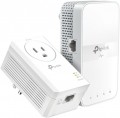Wired speed
The maximum wired speed supported by the adapter.
When choosing according to this indicator, note that manufacturers usually indicate the theoretical maximum in the specifications. In fact, the wired speed can be noticeably lower (in particular, due to interference in the mains). In addition, it may be limited by other factors: for example, if the adapter has only one 100 Mbps Fast Ethernet port, then its actual bandwidth cannot exceed 100 Mbps, even if the specifications indicate a wired speed of 500 Mbps .
Nevertheless, the higher the claimed speed (
1 Gbps), the higher the practical one, all other things being equal. So for tasks related to the transfer of large amounts of data or requiring a quick response (watching/broadcasting high-definition video, working with torrents, online games), you should choose the “faster” models.
LAN
The number of output connectors provided in the adapter design.
There are LAN ports with different bandwidth. So Fast Ethernet provides data transfer rates up to
100 Mbps ; such indicators are quite enough for most simple tasks and even for watching high-definition video in streaming mode. At the same time, as technology develops, this standard is gradually losing ground to the more advanced Gigabit Ethernet at speeds up to
1 Gbps. This option can be especially useful for transferring large amounts of information, as well as in cases where several network devices are connected to one port at once.
The presence
of several Ethernet connectors allows you to simultaneously connect several devices to the adapter (for example, a PC, a printer and a network TV) without the use of routers and other additional equipment. Also note that one set may include adapters with a different number of connectors. As a rule, in such cases, one device has 1 network port and works “at the input” (for example, an Ethernet cable from the provider is connected to it), the remaining adapters act as switches for several devices.
MESH mode
Ability of the device to operate as a MESH network node. In this case, the so-called seamless mode of operation is implemented: the entire network is seen as a single whole, switching between access points, if necessary, occurs automatically, in such cases the connection is not interrupted and the user does not notice the transition to another network node at all. This is one of the key differences from using repeaters. Another difference is dynamic routing: MESH network nodes automatically determine the optimal signal traversal mode. Due to this, as well as due to some other features of this technology, the presence of "intermediaries" on the signal path practically does not affect the connection speed (unlike the repeaters). The main disadvantage of
equipment with MESH mode is the relatively high cost.

